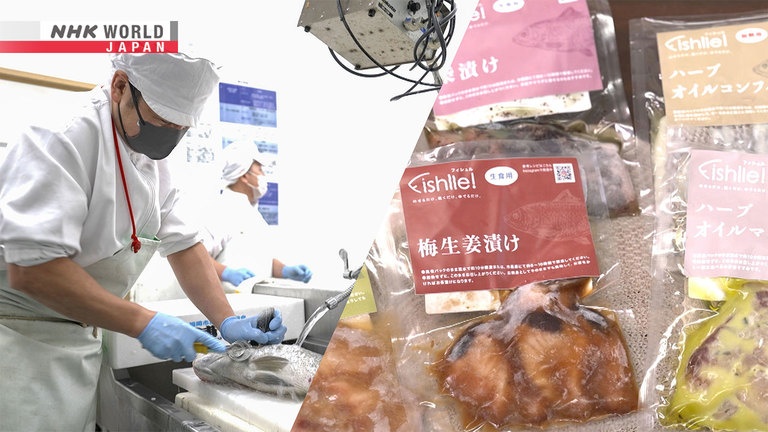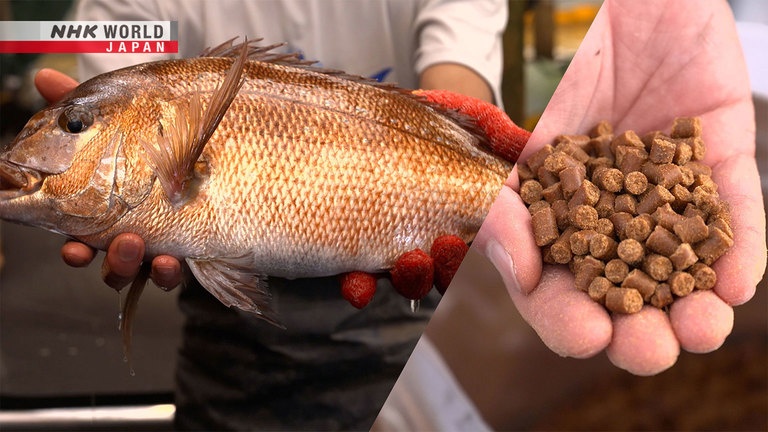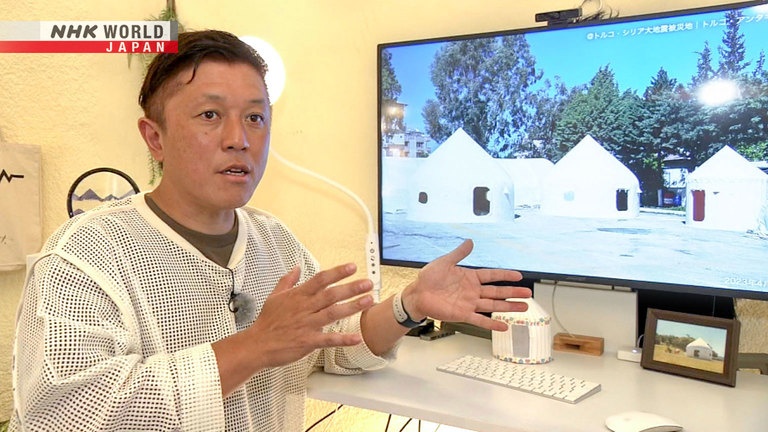Winds of Change in Japan's Seafood Industry
This episode shows how companies in Japan's seafood industry are adapting their business models to overcome challenges and increase sales.
[In Focus: China Powers Ahead in Global Auto Market]
The global auto industry is undergoing enormous changes as carmakers switch to clean energy vehicles and roll out smart technologies. This is fueling a realignment of the major players, with China moving closer to the front of the line.
[Global Trends: Japan's Inflatable Homes Offer Relief to Disaster Areas]
The frequency of earthquakes and other natural disasters around the world mean there is a constant need for temporary housing. We meet a university professor in Japan who designed an inflatable house that's providing relief to evacuees.
*Subtitles and transcripts are available for video segments when viewed on our website.
Winds of Change in Japan's Seafood Industry

With only certain types of fish being considered valuable, a sizeable portion of fish caught by professional fishermen end up being discarded. Wanting to eliminate this waste and make use of as much of their catch as possible, a Japanese company has come up with a unique business model that allows them to sell most types of unwanted fish.

Standard fish feed is usually made from powder containing a large amount of actual fish meat. However, rising costs have inspired a feed producer to create a new affordable type of fish feed that contains no fish meat and is made primarily from plant-based powder.
Global Trends

The temporary dwelling takes about 4 hours to construct and has insulation to make it habitable year-round.

Prof. Kitagawa decided to develop temporary housing that could be set up immediately after disaster struck.
Transcript
Carmakers from China took center stage at a major auto show in Europe last month.
The number of Chinese participants more than doubled from the previous event two years ago.
With the European Union planning to phase out diesel and gasoline cars by 2035,
many Chinese electric carmakers are counting on strong demand from the continent.
"Chinese EVs have a big advantage in autonomous driving and other smart technologies.
We also have a solid supply chain backing them."
The leader of one of Europe's car-making powerhouse has taken note of China's rise.
"In the 1980s, Japanese cars were said to be overrunning all other markets.
20 years later it was cars made in Korea.
Today it's Chinese electric cars."
China has quickly made its mark on the global market.
Three out of the 5 biggest sellers of EVs are Chinese firms according to a research firm.
The surge in demand for EVs is reshaping the global auto industry.
China is on track to become the biggest automobile exporter this year.
That means Japan would relinquish the top spot it has held for many years.
The country's automakers have been struggling to sell cars in China as they fall behind in the EV race.
Iconic Japanese brand Mitsubishi Motors is reportedly withdrawing from production in China due to its sluggish sales.
But China's rapid rise may not go unchecked.
The European Commission announced in recent weeks it's launching an investigation
into the subsidies that Chinese makers get from Beijing.
Global markets are now flooded with cheaper Chinese electric cars.
Their prices kept artificially low by huge state subsidies.
This is distorting our market,
and as we do not accept this distortion from the inside in our market,
we do not accept this from the outside.
If the probe finds that the state subsidies are giving an unfair advantage to Chinese EVs sold in Europe,
it could lead to the imposition of tariffs.
China has expressed its dissatisfaction with the move.
"The investigation by the European Union aims to shield its own industry in the name of fair competition.
But this is a case of blatant protectionism."
While the EU says it has no intention to cut itself off from China,
officials from Europe's big car-making nations voiced support for the probe.
"Europe must show it is determined to defend its economic and industrial interests.
So from that point of view, the probe is a very good decision which I welcome."
"It's good that the European Commission is taking a close look at these market segments and further steps
- should it turn out that there is something to it - will then have to be taken."
Carmakers from Japan, the US, Europe and South Korea have all had their own experiences
of being both welcomed and shunned in overseas markets.
Now it's China's turn as the shift to EVs puts the country in the spotlight.
Antakya, in southern Turkey, was devastated by earthquakes that hit the region earlier this year.
Soon after the disaster, three tent-shaped dwellings arrived from Japan.
They have plenty of headroom and the floor area is the size of a standard hotel unit.
There's enough space for a family of four.
Japan plans to send about 100 of the temporary homes to Turkey within this year.
Hello and welcome.
I've been waiting for you.
The home was developed by Professor Kitagawa Keisuke.
He started on a quest to build it after being issued a challenge of sorts by elementary schoolchildren
staying in an evacuation shelter after the 2011 Great East Japan earthquake and tsunami.
"Boys in the 3rd and 4th grades told me
they couldn't understand why it took half a year to build temporary housing.
They said, 'You're a college professor,
you should be able to figure out how to do it in a few weeks.'"
The professor teamed up with a private company to develop the house.
Setting it up is very easy.
First, it's unpacked from its case...
then it's fixed to the ground...
and inflated with an air pump.
The next step - spraying polyurethane foam on the inside -
is designed to keep the home comfortable inside regardless of the weather outside.
The whole job is done in about 4 hours.
Testing shows the dwelling can withstand winds of almost 290 kilometers per hour -
stronger than the gusts produced by a super typhoon.
Professor Kitagawa is also focusing his research on lowering costs by using materials
that can be easily sourced locally in the disaster-hit areas.
Starch glue in particular has caught his attention as an adhesive.
It's made from potatoes, which are found pretty much anywhere.
"If you mix it with water and finely shredded paper and fabric, you get something like this."
Now you have the heat insulating material for the dwelling.
Lined with polyurethane, it costs about 18,000 dollars to make one of these homes.
But Kitagawa says using a plant-based glue made from potatoes, corn, or rice will reduce the cost significantly.
From Japan's Tohoku region to Turkey in the Middle East,
lessons learned from past disasters are being applied and refined
to help people cope with whatever might come next.
With the cost of standard fish feed being highly volatile,
one company has come up with a plant-based feed to provide fish farmers with a more stable alternative.
Another company is taking difficult to sell fish
and turning them into a variety of delicious food products.
Today's On-Site Report features businesses that are tackling current issues facing Japan's seafood industry.
When fishing nets pull in their catch, they contain different types of fish.
In addition to the desirable fish,
they also pull in various types that are difficult or impossible to sell, which are called bycatch.
For example, this lionfish.
The poisonous spines on its fins make it difficult to process.
Or, this type of filefish that's considered edible,
but is difficult to sell when it's not in season.
Other fish can be considered bycatch because they don't meet size requirements
or because they just don't look appetizing enough for consumers.
Because they're considered unsellable, bycatch fish are usually discarded or sometimes used as bait.
Our crew recently traveled to the southwestern city of Fukuoka,
to meet Inokuchi Tsuyoshi who has started a business that makes use of bycatch.
Years of working in the seafood business made him aware
of the large amounts of fish that were going to waste.
"It's hard to see any kind of fish go to waste,
but especially fish that are being thrown away for reasons
that have nothing to do with their quality or flavor!"
"Good morning!"
Inokuchi sources the fish from a buyer who regularly purchases from several different fishermen.
From St. Peter's fish and Stargazers to Spotted Tail Morwong,
the middleman doesn't just source the fish for Inokuchi,
he even does some prep work to keep them fresh!
Some species, require a little more work than others.
For example, certain types of fish, like this tilapa,
have completely different bone structures and requires a skilled professional to debone them.
Inokuchi has come up with a variety of ways to season and flavor bycatch fish
in order to accentuate their unique flavor and texture profiles.
From thinly sliced gurnard in soysauce marinade to emperor bream in herb oil confit,
the company currently uses over 50 different seasonings to flavor its fish.
Since Inokuchi has no control over the amount or type of fish that comes in with each delivery,
he has created a unique business model to sell them.
In March of 2021, he opened a seafood box subscription service where registered clients across Japan
can regularly receive different types of rare fish delivered right to their door.
In less than 3 years, the company has already surpassed 11,000 subscribers.
Nanami and Daisuke Suzuki have been customers for about 6 months.
On the day we visited, they were trying yellow croaker marinated in soy sauce.
They chose to serve it on bowl of white rice with raw egg on top.
It's really tasty!
Offering rare types of fish is a great idea!
We always look forward to each delivery!
"Depending on the way we season or flavor it, any type of fish can become a hit.
By offering this service, I hope to provide our clients with a broad range of tasty fish
while reducing the amount of bycatch that goes to waste across Japan."
Along the coast of Ehime Prefecture...
Sea Bream farms are thriving.
The feed these red sea bream are eating
differs from standard feed and doesn't contain any fish powder at all.
After seeing volatile price swings in the fish-feed market,
Aquaculturist Akasaka Ryutaro decided to try developing fish feed without fish powder.
"Nearly 3 quarters of our costs usually go into fish feed.
When fish powder runs low, feed prices can sky rocket,
like they did 5 years ago when they increased by about 30%."
Akasaka, also felt that creating a feed
that didn't use fish powder could lessen the impact on marine resources, such as anchovy,
which is often used as a main ingredient in standard fish feeds.
In place of fish powder, Akasaka came up with a plant-based mixture
using soy beans, corn, and white sesame seeds for feeding young adult red sea bream.
The soybeans and corn provide the needed protein.
And the sesame seeds are rich in antioxidants,
which Akasaka says helps keep the meat fresh for longer periods of time.
After finding the right balance of ingredients, Akasaka ran into another major challenge.
"The biggest difference is in how the fish respond to it.
The feed made with fish powder gives off a strong odor,
so the moment you drop it in, they start devouring it.
The plant-based feed, however, doesn't have a fishy odor,
so it takes them much longer to react to it and start eating."
With standard feed, adult red sea bream only need to be fed once in the morning and once in the evening.
But this method doesn't work with the plant-based feed.
Aware of the Sea Bream's habit of coming to the surface when hungry,
Akasaka found that he could get them to eat the plant-based feed by pouring in smaller amounts
during the times the fish were closer to the surface.
After making this discovery, he then introduced an AI-driven automated feeding system.
It can gauge the appetite level of the red sea bream based on their movements
and determine the ideal amount of feed as well as when to release it.
Young adult sea breams' appetites peak during the last 6 months before harvesting.
By changing to plant-based feed,
aquaculturists don't have to worry about volatile pricing affecting their feed costs.
In 2021, they began selling red seabream fed with plant-based feed.
The fish have even found their way into a local sushi restaurant.
"Fish that are given standard fish feed can be a bit smelly.
But these sea bream don't smell at all and have just the right amount of fat."
This year, Akasaka expects to ship about about 100,000 fish raised on plant-based feed.
The texture and flavor differences allow him sell them for 10% to 20% more
than red sea bream raised on standard feed.
"I want to continue transitioning from fish-based feeds to plant-based feeds,
because it will also help to protect our natural resources.
If we can use it to feed 1 million red sea bream,
I believe this change will have a positive impact on the ocean."